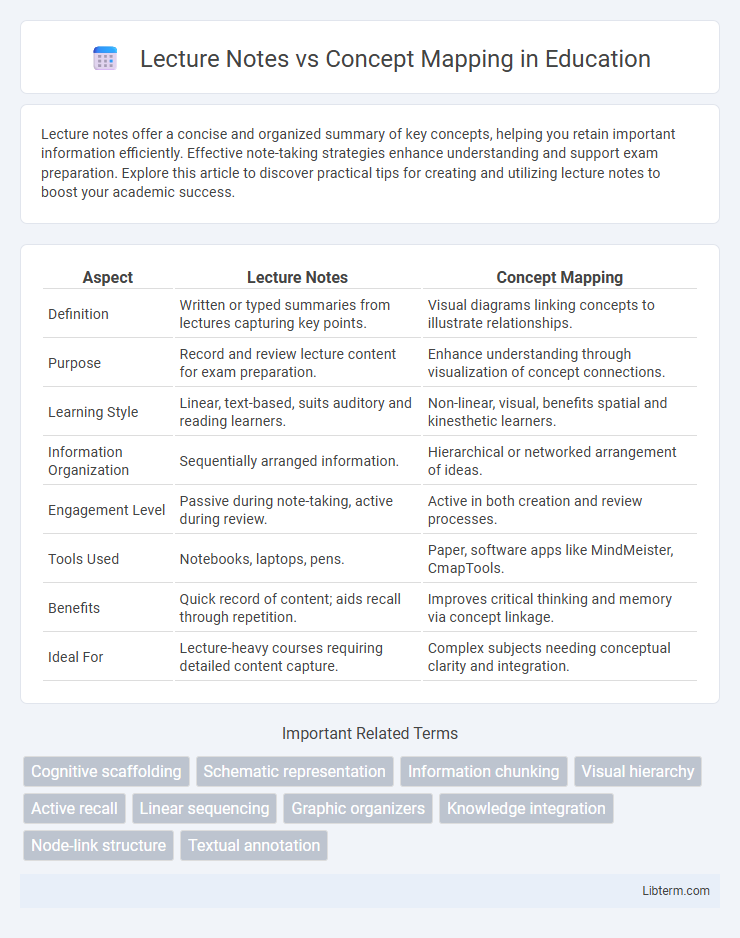Lecture notes offer a concise and organized summary of key concepts, helping you retain important information efficiently. Effective note-taking strategies enhance understanding and support exam preparation. Explore this article to discover practical tips for creating and utilizing lecture notes to boost your academic success.
Table of Comparison
| Aspect | Lecture Notes | Concept Mapping |
|---|---|---|
| Definition | Written or typed summaries from lectures capturing key points. | Visual diagrams linking concepts to illustrate relationships. |
| Purpose | Record and review lecture content for exam preparation. | Enhance understanding through visualization of concept connections. |
| Learning Style | Linear, text-based, suits auditory and reading learners. | Non-linear, visual, benefits spatial and kinesthetic learners. |
| Information Organization | Sequentially arranged information. | Hierarchical or networked arrangement of ideas. |
| Engagement Level | Passive during note-taking, active during review. | Active in both creation and review processes. |
| Tools Used | Notebooks, laptops, pens. | Paper, software apps like MindMeister, CmapTools. |
| Benefits | Quick record of content; aids recall through repetition. | Improves critical thinking and memory via concept linkage. |
| Ideal For | Lecture-heavy courses requiring detailed content capture. | Complex subjects needing conceptual clarity and integration. |
Introduction to Lecture Notes and Concept Mapping
Lecture notes are structured records created by students during or after classes to capture key information, explanations, and examples presented by the instructor. Concept mapping is a visual representation technique that organizes and links ideas, illustrating relationships between concepts to enhance understanding and memory retention. Both tools serve to facilitate learning, with lecture notes emphasizing comprehensive content capture and concept mapping focusing on the graphical organization of knowledge.
Key Differences Between Lecture Notes and Concept Mapping
Lecture notes primarily capture linear, detailed information conveyed during lectures, emphasizing verbatim content and sequential organization. Concept mapping visually represents relationships between core ideas using nodes and connecting lines, fostering deeper understanding and integration of knowledge. While lecture notes enhance recall of specific facts, concept mapping promotes critical thinking by illustrating hierarchical structures and interconnections within a subject.
Benefits of Taking Traditional Lecture Notes
Taking traditional lecture notes enhances information retention by actively engaging the brain in processing and organizing content during lectures. Writing notes by hand promotes deeper cognitive connections, improving understanding and recall compared to passive listening or recognition-based methods. Structured lecture notes provide a clear, linear framework that facilitates systematic review and efficient exam preparation.
Advantages of Concept Mapping for Learning
Concept mapping enhances learning by visually organizing and representing knowledge, which facilitates better comprehension and retention of complex information. It promotes active learning through the integration of new concepts with existing knowledge networks, improving critical thinking and problem-solving skills. Concept maps also enable learners to identify relationships between ideas clearly, making revision and collaborative learning more effective compared to linear lecture notes.
When to Use Lecture Notes vs Concept Mapping
Lecture notes are ideal for capturing detailed information during presentations or classroom sessions, allowing for comprehensive review of facts and explanations. Concept mapping is more effective for organizing knowledge, highlighting relationships between ideas, and facilitating deeper understanding of complex subjects. Choose lecture notes when accuracy and completeness are essential, and concept mapping when synthesizing information or preparing for problem-solving tasks.
Techniques to Improve Lecture Note-Taking
Effective lecture note-taking techniques include employing the Cornell Method, which structures notes into cues, main notes, and summaries to enhance retention and review efficiency; utilizing the outlining method to organize information hierarchically, connecting main topics with subpoints for clarity; and integrating visual elements from concept mapping, such as linking related ideas through diagrams, which promotes deeper understanding and memory recall. Active listening paired with synthesizing key concepts rather than transcribing verbatim significantly improves comprehension and note quality. Incorporating digital tools like OneNote or Notability also supports dynamic note organization and seamless integration of multimedia content.
Steps to Create Effective Concept Maps
Effective concept maps start by identifying the central topic and listing key concepts related to the subject. Next, organize these concepts hierarchically, connecting them with labeled linking phrases that illustrate relationships. Finally, review and refine the map to ensure clarity, coherence, and accurate representation of knowledge structures for enhanced understanding and retention.
Research Findings on Learning Outcomes
Research findings indicate that concept mapping enhances learning outcomes by promoting deeper understanding and long-term retention compared to traditional lecture notes. Studies show that students using concept maps demonstrate improved critical thinking skills and better integration of complex information. Empirical data suggest that concept mapping facilitates active engagement and more effective organization of knowledge, leading to higher academic performance.
Tools and Resources for Note-Taking and Mapping
Digital tools like Microsoft OneNote, Evernote, and Notion enhance lecture note-taking by enabling organized, searchable, and multimedia-rich content, while concept mapping benefits from specialized software such as MindMeister, Coggle, and XMind that support visual structuring and hierarchical representation of ideas. Integrating these tools facilitates efficient knowledge capture and retrieval, leveraging features like collaboration, tagging, and cross-linking to optimize study workflows. Utilizing both methods with appropriate technological resources enriches comprehension and retention by appealing to diverse cognitive processes.
Choosing the Right Method for Your Study Style
Lecture notes capture detailed information linearly, ideal for learners who prefer structured, comprehensive content review. Concept mapping visually organizes relationships between ideas, benefiting those who grasp material better through spatial and relational understanding. Selecting the right method depends on whether you favor sequential detail retention or holistic concept integration for effective studying.
Lecture Notes Infographic

 libterm.com
libterm.com